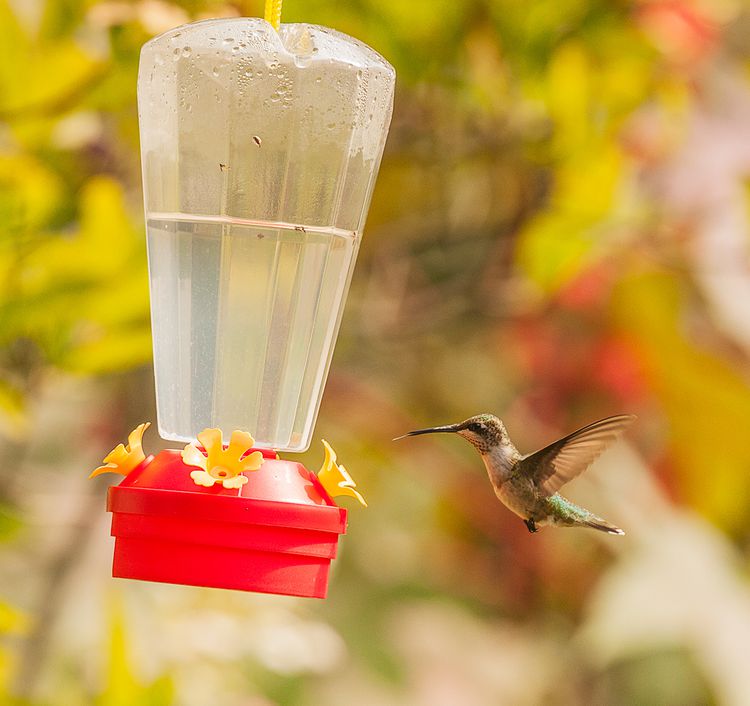Hummingbirds are hungry little creatures. These migratory aerial acrobats need a lot of energy to beat their tiny wings so fast. Depending on which species of hummer we're talking about, that may be 10 to more than 80 flaps per second. And that's just while hovering in place! There's no need to buy expensive nectar to have these fascinating birds flocking to your feeders. Follow the easy hummingbird food recipe below; it only takes a few minutes to make and requires two simple ingredients. Here's how to whip up a batch today.
Easy Hummingbird Food Recipe
All you need for the homemade hummingbird food recipe is sugar and water. Combine one-quarter cup of refined white sugar in one cup of hot water. It's a good idea to boil the water first. "This way you kill any fungi or bacteria in the water to start off, making it as safe as possible for your hummer visitors," says Emma Greig, Project Leader with Project FeederWatch at the Cornell University Ornithology Lab. Plus, the sugar dissolves faster in hot water, so that's another reason to boil it first. Then stir or shake the solution until the sugar is completely dissolved—the water will turn from cloudy to clear. Finally, allow the solution to come to room temperature before filling your feeders.
To make a larger batch, which you will want to do if you have multiple hummingbird feeders, just stick to the one-to-four ratio of sugar to water. If you make more than your feeders will hold, you can keep the extra in the refrigerator. When refilling your feeders, allow the sugar solution to return to room temperature first.
What Sugar is Best for Hummingbird Feeders?
Be sure to use only refined white sugar in making your solution. "Brown, organic, molasses, and honey all have too much iron for hummingbirds," says Audubon Conservation Biologist Aimee Tomcho. "Other sweetening agents have additional ingredients that can prove detrimental to the hummingbirds. Never use artificial sweeteners to make hummingbird nectar," she adds.
Should You Add Red Food Coloring?
The answer is no, don't add red food coloring to your hummingbird food recipe. "We don't recommend adding anything unnecessary to any bird food, including hummingbird nectar, because the impacts of most additives on bird health are unknown. So, better to keep it as pure and simple as possible, just sugar and water," says Greig. Hummingbirds are attracted to red, so many feeders have a bit of red in their design. That's a safer way to catch hummers' attention.
How Long Will the Homemade Hummingbird Food Recipe Keep?
If you make a large batch, keep the extra refrigerated, but not for more than two weeks. "In hot weather, the feeder should be emptied and cleaned twice per week. In cooler weather, once per week is enough," says Tomcho. If you need to refill the feeders more frequently because hummers are emptying them, you should still clean them well each time before adding more nectar.
Tips for Feeding Hummingbirds
The Audubon Society recommends hanging feeders in the shade to prevent the sugar solution from fermenting; if you hang multiple feeders, space them far enough apart so feeding hummingbirds can't see each other. This should prevent one hummer from dominating all feeders.
Once a week (or twice a week in hot weather), clean your hummingbird feeders with a solution of one part white vinegar to four parts water. Rinse well—at least three times—before refilling with your homemade sugar water solution. Avoid using dish soap to clean feeders because they can leave a harmful residue.
Don't take the feeders down too soon in the fall. Hummingbirds will begin to migrate according to the changing day length. However, there often are a few stragglers that will need the energy your feeders provide to continue their journey.
Include plants that hummingbirds are attracted to in your gardens. "Native flowering plants are the best source for feeding hummingbirds in your yard," says Tomcho. Hummers are particularly fond of red tubular flowers. Some of the best plants for attracting and feeding hummingbirds are bee balm, salvia, coralbells, columbine, cardinal flower, coral honeysuckle, trumpet vine, and Indian pink.
Audubon Vermont Environmental Educator, Gwendolyn Causer says, "Planting multiple patches of flowers is a good idea since male hummingbirds can be territorial. You don't need to plant a huge garden to make a difference. Even a hanging basket can be a wonderful source of nectar."




















